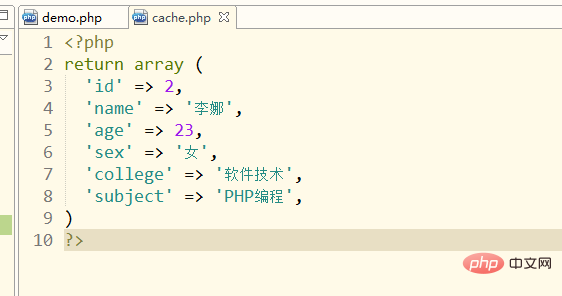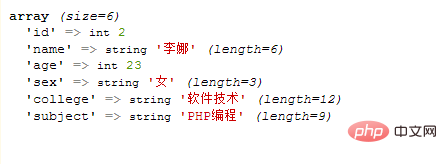Home > Article > Backend Development > PHP file operation: how to save array data to a file (two methods)
In the previous article "How to check for null values using PHP (4 methods)", we introduced the method of using PHP to check whether a given value (variable) is null. This time we will talk about data storage in PHP and see how to store array data in a specified file. Interested friends can learn about it~
→Related recommendations: 《php file operation series summary (continuously updated~)》
During the development process, we often use var_dump() to print the array content, but sometimes it is inconvenient for us to view debugging information through the browser. At this time, the information can be output to a file for viewing. Today, this article will introduce to you two methods of writing array data to files.
Method 1: Use the var_export() function
var_export - Output or return the parsable string representation of the variable
Syntax: var_export(mixed $value, bool $return = false)
value: The variable name you want to output.
return: When this parameter is true, var_export() will return a variable instead of outputting it.
This function returns structural information about the variables passed to the function. It is similar to var_dump(), except that the representation returned is legal PHP code. We can return a representation of a variable by setting the second parameter of the function to TRUE.
Let’s use the following example to see how to use the var_export() function to save array data into a file
<?php
//$cache的值是更新缓存时从数据库中取出来的
$cache = array(
'id' => 2,
'name' => '李娜',
'age' => 23,
'sex' => '女',
'college' => "软件技术",
'subject' => "PHP编程"
);
//将数据写入缓存文件
$content = "<?php\nreturn ".var_export($cache,true)."\n?>"; //这里使用var_export()
file_put_contents('./cache.php', $content);
?>Analysis code:
var_export($cache,true)Return the parsable string of the array variable
Concatenate the strings and assign the value to the variable $content;
Write data$content in the cache.php file. The file_put_contents() function can write a string into a file. For details, you can read the article "
 Call the cache file You only need to use require() to copy the contents of the cache file to a variable, and then output the array variable:
Call the cache file You only need to use require() to copy the contents of the cache file to a variable, and then output the array variable:
<?php $cache = require('./cache.php'); var_dump($cache); ?>
The output result is:

Method 2: Use the serialize methodUse serialize to serialize the array and store it in the file; when calling, use unserialize to restore it.
Let’s use the following example to see how to use the serialize() function to store array data into a file
<?php
$file='./cache.php';
$cache = array(
'id' => 2,
'name' => '李娜',
'age' => 23,
'sex' => '女',
'college' => "软件技术",
'subject' => "PHP编程"
);
//缓存
if(false!==fopen($file,'w+')){
file_put_contents($file,serialize($cache));//写入缓存
}
?>Use
file_put_contents($file,serialize($cache)) Store the serialized array data in the cache.php file. Therefore, in cache.php, which was an empty file at the beginning, the current content is:
 When reading the cache, you need to use unserialize to restore the data in cache.php
When reading the cache, you need to use unserialize to restore the data in cache.php
<?php //读出缓存 $file='./cache.php'; $handle=fopen($file,'r'); $cache=unserialize(fread($handle,filesize($file))); var_dump($cache); ?>
The output result is:
)
PHP interview questions summary (collection)》《php video tutorial》
The above is the detailed content of PHP file operation: how to save array data to a file (two methods). For more information, please follow other related articles on the PHP Chinese website!